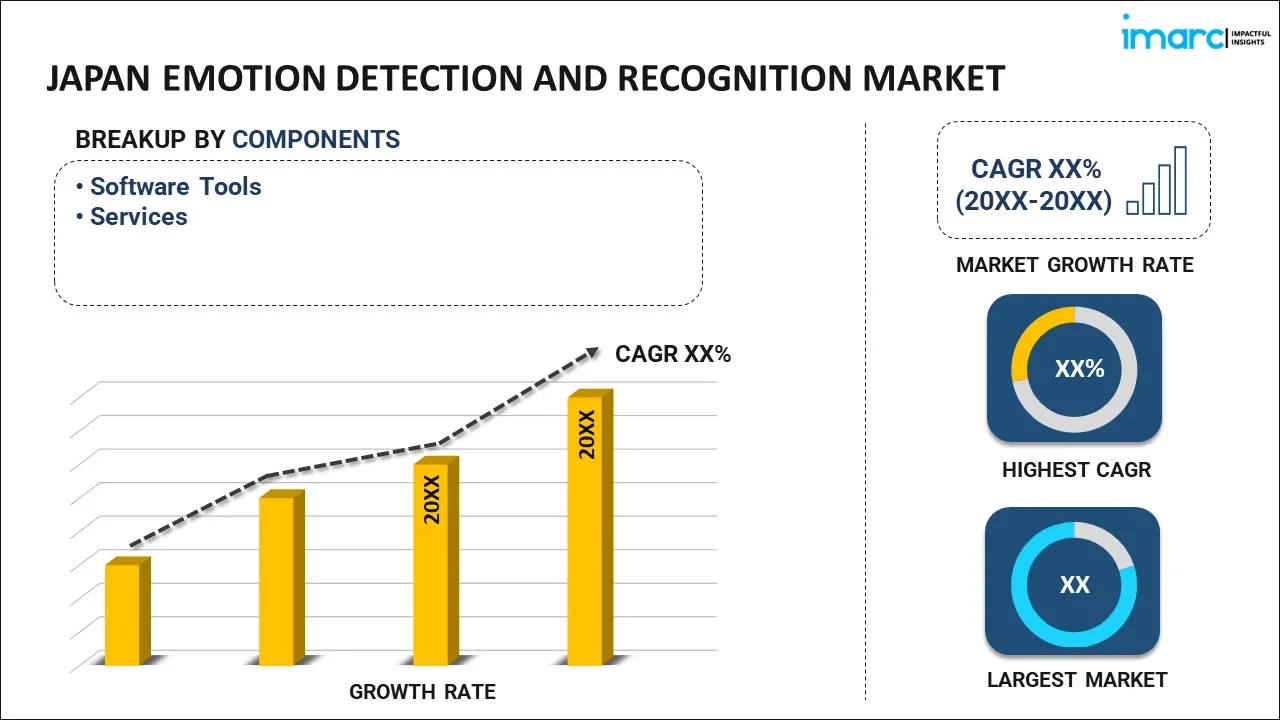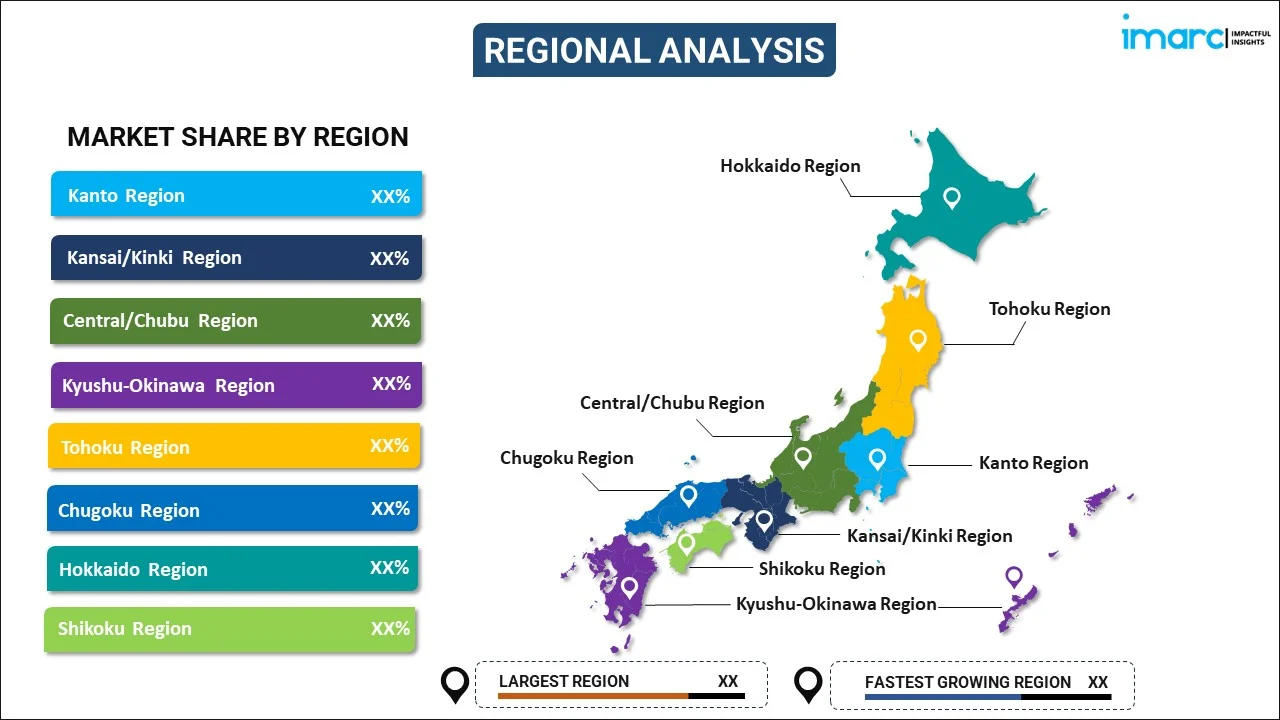
Japan Emotion Detection and Recognition Market Report by Component (Software Tools, Services), Technology (Pattern Recognition Network, Machine Learning, Natural Language Processing, Bio-Sensors Technology, Feature Extraction and 3D Modelling, and Others), Application (Law Enforcement, Surveillance and Monitoring, Marketing and Advertising, Media and Entertainment, and Others), End User (Government, Healthcare, Retail, Entertainment, Transportation, Defence and Security Agency, Education, and Others), and Region 2025-2033
Market Overview:
Japan emotion detection and recognition market size reached USD 3.1 Billion in 2024. Looking forward, IMARC Group expects the market to reach USD 13.3 Billion by 2033, exhibiting a growth rate (CAGR) of 16.2% during 2025-2033. The inflating need among businesses for understanding customer emotions and preferences is primarily driving the market growth.
|
Report Attribute
|
Key Statistics
|
|---|---|
|
Base Year
|
2024 |
|
Forecast Years
|
2025-2033
|
|
Historical Years
|
2019-2024
|
| Market Size in 2024 | USD 3.1 Billion |
| Market Forecast in 2033 | USD 13.3 Billion |
| Market Growth Rate (2025-2033) | 16.2% |
Emotion detection and recognition refer to the process of identifying and understanding human emotions through the analysis of various cues, such as facial expressions, voice tone, body language, and physiological signals. This technology leverages artificial intelligence, machine learning, and deep learning algorithms to interpret and categorize emotions accurately. By detecting emotions like happiness, sadness, anger, fear, and surprise, it aims to provide valuable insights into an individual's emotional state and psychological well-being. Emotion recognition has diverse applications, ranging from market research and customer feedback analysis to mental health monitoring and human-computer interaction. It plays a significant role in improving human-machine communication, creating empathetic virtual assistants, and enhancing user experiences in fields like healthcare, education, and entertainment.
Japan Emotion Detection and Recognition Market Trends:
The Japan emotion detection and recognition market are experiencing significant growth driven by several key factors. One of the primary drivers is the increasing interest in emotional intelligence applications across various industries. Emotion detection technology finds widespread use in fields like retail, healthcare, customer service, and entertainment, where understanding customer emotions and preferences is crucial for enhancing user experiences and making informed business decisions. Moreover, the COVID-19 pandemic has accelerated the adoption of emotion recognition technology in Japan. With the limitations on in-person interactions, there is a growing need for virtual platforms and digital solutions that can gauge emotions, ensuring better engagement during online meetings, education, and telehealth consultations. The Japanese government's commitment to fostering innovation and technological advancements further fuels the market. Initiatives promoting research and development in AI and machine learning have paved the way for more sophisticated emotion recognition systems, making them more accurate and efficient. The market's growth is also propelled by the integration of emotion detection in wearable devices and smartphones, enabling users to monitor their emotional well-being and offering potential applications in mental health support. As the technology continues to evolve and gain acceptance, the Japan emotion detection and recognition market are expected to witness substantial expansion, with opportunities spanning various sectors and applications.
Japan Emotion Detection and Recognition Market Segmentation:
IMARC Group provides an analysis of the key trends in each segment of the market, along with forecasts at the country level for 2025-2033. Our report has categorized the market based on component, technology, application, and end user.
Component Insights:

- Software Tools
- Facial Expression Recognition
- Bio-Sensing Software Tools and Apps
- Speech and Voice Recognition
- Services
- Storage and Maintenance
- Consulting and Integration
The report has provided a detailed breakup and analysis of the market based on the component. This includes software tools (facial expression recognition, bio-sensing software tools and apps, and speech and voice recognition) and services (storage and maintenance and consulting and integration).
Technology Insights:
- Pattern Recognition Network
- Machine Learning
- Natural Language Processing
- Bio-Sensors Technology
- Feature Extraction and 3D Modelling
- Others
A detailed breakup and analysis of the market based on the technology have also been provided in the report. This includes pattern recognition network, machine learning, natural language processing, bio-sensors technology, feature extraction and 3D modelling, and others.
Application Insights:
- Law Enforcement, Surveillance and Monitoring
- Marketing and Advertising
- Media and Entertainment
- Others
The report has provided a detailed breakup and analysis of the market based on the application. This includes law enforcement, surveillance and monitoring, marketing and advertising, media and entertainment, and others.
End User Insights:
- Government
- Healthcare
- Retail
- Entertainment
- Transportation
- Defence and Security Agency
- Education
- Others
A detailed breakup and analysis of the market based on the end user have also been provided in the report. This includes government, healthcare, retail, entertainment, transportation, defence and security agency, education, and others.
Regional Insights:

- Kanto Region
- Kansai/Kinki Region
- Central/ Chubu Region
- Kyushu-Okinawa Region
- Tohoku Region
- Chugoku Region
- Hokkaido Region
- Shikoku Region
The report has also provided a comprehensive analysis of all the major regional markets, which include Kanto Region, Kansai/Kinki Region, Central/ Chubu Region, Kyushu-Okinawa Region, Tohoku Region, Chugoku Region, Hokkaido Region, and Shikoku Region.
Competitive Landscape:
The market research report has also provided a comprehensive analysis of the competitive landscape. Competitive analysis such as market structure, key player positioning, top winning strategies, competitive dashboard, and company evaluation quadrant has been covered in the report. Also, detailed profiles of all major companies have been provided.
Japan Emotion Detection and Recognition Market Report Coverage:
| Report Features | Details |
|---|---|
| Base Year of the Analysis | 2024 |
| Historical Period | 2019-2024 |
| Forecast Period | 2025-2033 |
| Units | Billion USD |
| Scope of the Report | Exploration of Historical and Forecast Trends, Industry Catalysts and Challenges, Segment-Wise Historical and Predictive Market Assessment:
|
| Components Covered |
|
| Technologies Covered | Pattern Recognition Network, Machine Learning, Natural Language Processing, Bio-Sensors Technology, Feature Extraction and 3D Modelling, Others |
| Applications Covered | Law Enforcement, Surveillance and Monitoring, Marketing and Advertising, Media and Entertainment, Others |
| End Users Covered | Government, Healthcare, Retail, Entertainment, Transportation, Defence and Security Agency, Education, Others |
| Regions Covered | Kanto Region, Kansai/Kinki Region, Central/ Chubu Region, Kyushu-Okinawa Region, Tohoku Region, Chugoku Region, Hokkaido Region, Shikoku Region |
| Customization Scope | 10% Free Customization |
| Post-Sale Analyst Support | 10-12 Weeks |
| Delivery Format | PDF and Excel through Email (We can also provide the editable version of the report in PPT/Word format on special request) |
Key Questions Answered in This Report:
- How has the Japan emotion detection and recognition market performed so far and how will it perform in the coming years?
- What has been the impact of COVID-19 on the Japan emotion detection and recognition market?
- What is the breakup of the Japan emotion detection and recognition market on the basis of component?
- What is the breakup of the Japan emotion detection and recognition market on the basis of technology?
- What is the breakup of the Japan emotion detection and recognition market on the basis of application?
- What is the breakup of the Japan emotion detection and recognition market on the basis of end user?
- What are the various stages in the value chain of the Japan emotion detection and recognition market?
- What are the key driving factors and challenges in the Japan emotion detection and recognition?
- What is the structure of the Japan emotion detection and recognition market and who are the key players?
- What is the degree of competition in the Japan emotion detection and recognition market?
Key Benefits for Stakeholders:
- IMARC’s industry report offers a comprehensive quantitative analysis of various market segments, historical and current market trends, market forecasts, and dynamics of the Japan emotion detection and recognition market from 2019-2033.
- The research report provides the latest information on the market drivers, challenges, and opportunities in the Japan emotion detection and recognition market.
- Porter's five forces analysis assist stakeholders in assessing the impact of new entrants, competitive rivalry, supplier power, buyer power, and the threat of substitution. It helps stakeholders to analyze the level of competition within the Japan emotion detection and recognition industry and its attractiveness.
- Competitive landscape allows stakeholders to understand their competitive environment and provides an insight into the current positions of key players in the market.
Need more help?
- Speak to our experienced analysts for insights on the current market scenarios.
- Include additional segments and countries to customize the report as per your requirement.
- Gain an unparalleled competitive advantage in your domain by understanding how to utilize the report and positively impacting your operations and revenue.
- For further assistance, please connect with our analysts.
 Inquire Before Buying
Inquire Before Buying
 Speak to an Analyst
Speak to an Analyst
 Request Brochure
Request Brochure
 Request Customization
Request Customization




.webp)




.webp)












